| Construction Rating: | starstarstarstarstar_border |
| Flight Rating: | starstarstarstarstar |
| Overall Rating: | starstarstarstarstar |
| Manufacturer: | PD Rocketry |
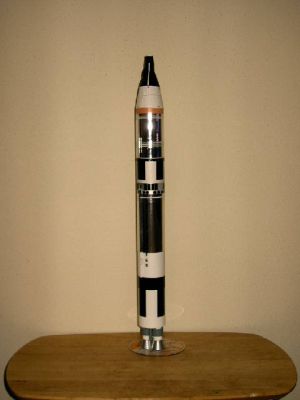
Brief:
PDRocketry's 1/54 semi-scale Gemini Titan 3 is basically a clone of the classic Estes kit from the mid to late 1960's
through the 1970's before it went OOP. It's almost an exact reproduction with some minor differences. PDRocketry's kit
consists of all body tubes made with white kraft paper cut to correct length, Alps water slide decals, 24"
pre-assembled mylar parachute, laser cut centering rings, and all patterns, sheets, instructions, and guides.
This model is not for the beginner nor average model rocketeer. Do not expect to assemble and finish this kit overnight...it isn't going to happen. Be prepared to spend a good amount of dedicated time working on this model if your desire is to produce a rare semi-scale kit that'll catch the eyes of others in the display case and at the launch site and one you'll be very proud of for a long time.
I personally had passed up the chance to obtain the original Estes GT-3 kit some years back (mainly because I didn't like the thought of this model using removable clear plastic fins for flight). After becoming a BAR in late 2003, I came to regret that decision to by pass that Estes GT-3 kit. A few years later, while surfing the internet of the various model rocket vendors, I was surprised and delighted to see that PDRocketry (then called by a somewhat different name, which I won't repeat here) had the 1/54 semi-scale Gemini Titan 3 kit that had the same dimensions as the Estes classic. I resolved then that I was going to put this kit on my "must buy; must build" list.
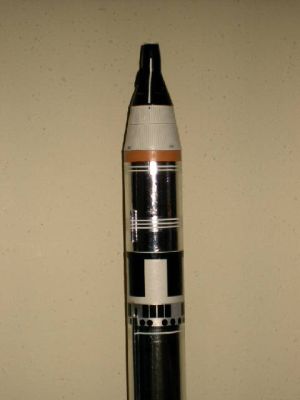
Construction:
The parts list of this kit is fairly extensive. It includes:
- 1 Body Tube -- Part #BT-70
- 1 Stuffer Tube -- Part #BT-20B
- 1 Parachute Tube -- Part #BT-60K
- 2 Engine Holder Tubes -- Part #BT-20G
- 3 Ring Sets -- Part #RA-2050
- 2 Launching Lugs -- Part #LL-2D
- 2 Engine Blocks -- Part #EB-20A
- 1 Dowel -- Part #WD-2
- 1 Ring Set -- Part #TA-21
- 2 Stage Coupler -- Part #JT-50B
- 1 Stage Coupler -- Part #JT-70A
- 1 Sheet Plastic Fin Material -- Part #CFS-20
- 2 Sheets Plastic Fin Material -- Part #CFS-40
- 1 Gemini Capsule -- Part #BNC-60AB
- 1 Shroud and Pattern Sheet -- Part #SP-21
- 1 Shock Cord -- Part #SC-2
- 1 Screw Eye -- Part #SE-1
- 1 Parachute (Preassembled) -- Part #PK24A
- 1 Paint Pattern Sheet -- Part #SP-21B
- 2 Self-Adhesive Strips -- Part #TH-1
- 1 Reject Engine Casing -- Part #EC-2
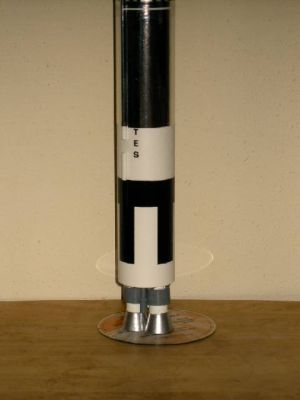
In addition to the materials included with the kit, the following tools and supplies will be needed:
- Modeling knife or single edge razor blade
- Scissors
- Extra strong white glue
- Ball point pen or sharp pencil
- Fine and extra fine grit sandpaper
- Clear butyrate dope
- Black, white and silver paint or dope
Before I got around to starting on my build of this model from PDRocketry, I had closely followed build threads of this model on the various model rocketry forums on the web to give myself a "heads up" in building a very presentable model. I have to give credit to several who gave plenty of insights/tips from which I learned plenty from including outstanding model rocketeers such as Drew and fred22 and Planet Andy among others.
When I placed my order to PDRocketry for this kit, I also ordered several more items you should consider getting to help enhance the build/finished product of this model: From BMS, I ordered several sheets of the chrome mirror-metalized trim Monokote adhesive, and the 1/54 Gemini Titan decals from Tango Papa Decals, which you will need if you wish to complete the detailing of your model--especially the markings on the Gemini capsule.
It's strongly recommended that you get one bottle of the Ambroid Pro-Weld adhesive for the construction of the clear plastic fin unit. I was unable to find any clear butyrate dope anywhere near where I live and couldn't find any suitable subsitution. Drew Tomko, one of the rocketeers whom I learned much from before this build, directed me to Doc's Caboose as a great source of the Ambroid Pro-Weld. I was able to get this item from the Doc (via e-mail & postal mail) in short order.
For the build, I pretty much followed the instructions step by step as given in the instruction sheets, which are four pages long. Make sure you've studied the instructions very well before starting to avoid any nasty surprises and/or glitches during your build.
One issue I had with this kit was the shroud patterns on the pattern sheet for the engine nozzles and the Gemini equipment/retro shroud. Mine came out a bit too small using the guide lines given. I had to use extra cardstock I had on hand to redo the shroud patterns (both the engine nozzles and Gemini adapter shrouds) to make just a little bit larger. It actually took me three tries before I could get a satisfactory fit for all three shrouds.
Before I began the build of this model, I decided I was going to not use the conduits (launch lugs) as given in the instructions as the means to guide the model during launch. My concern here was that since the lugs/conduits are three separate pieces and set flush with the main body tube, there might be too much friction with the clear plastic tubing for the plastic fin can that must be used to the model's stability. Add to the fact that sometimes a launch rod can rub on the model's paint finish and do who knows what (I've seen some clubs spray WD-40 on their launch rods before most everyone arrives for the day's launch). Instead, I "capped" all three of the launch lugs of my model with microfil and CA and decided to use two 1/4" launch lugs (1/8" dia) with a short balsa standoff on the opposite side of the main bodytube. These two "hot" launch lugs/standoffs were placed where the black patterns exist.
The other concern for me was on step #20 where you'll have to put your wood carving skills to work. I personally had none! I have to admit I was quite scared to tackle this step as I knew the job had to be done right the first and only time. What I did was make a pattern for the hatch windows for the capsule as shown in Figure 20 with the pattern drawn on a cardstock and then cut with scissors. I then traced the hatch window patterns at the apporiate position as shown in Figure 20. Then, after taking a deep breath (and maybe a prayer or two) I used my sharp X-Acto knife to slowly trim and chip away the balsa surface to get the desired recessed shape of the hatch windows. I also used a small emory board to sand the shape/groove to get the desired effect. Some of our rocket buddies have stated they used a Dremel to great effect for this step, however, I don't have one. The key here is to work slow and take your time. Once both hatch windows are uniform, stop right there and don't go any further! Sometimes doing too much to a job like this can do more harm than good. Save the next step here for the balsa sanding and sealing before the finish.
I forgot to mention Step #14 where I used the tri-fold cardstock paper method of attaching the elastic shockcord instead of cutting slits in the body tube.
Now the other roadblock many hit in a kit like this is the construction of the clear plastic fin can. I was no exception--in fact, I almost gave up on Step #25. I was unable to locate any clear butyrate dope nor any Ambroid Pro-Weld, which was highly recommended by Drew Tomko, but did as Drew suggested and obtained a bottle of the Pro-Weld from Doc's Caboose.
By this time, I had already ruined the thin clear plastic that was suppose to form the clear tubing from which the four thicker plastic fins are attached. This came from me trying to use another adhesive I got from Hobby Lobby that claimed to work on "anything." Well, it didn't work on the clear plastic tubing and made an unsightly mess that I simply had to throw away the plastic material. Lucky for me, I found an already formed clear plastic tube in my stash of spare model parts that I had been given from a good friend from the Dallas area. This plastic tubing just happened to slide over the GT-3's main bodytube perfectly. After cutting this new found clear plastic tubing to the correct length and having already received the Ambroid Pro-Weld from Doc Caboose, it took me only about 30 minutes to get the four clear plastic fins on and finish the job.
The instructions on Step #26 gives two options in cutting the clear plastic fins from the plastic sheet. I used extra sharp scissors as it's much easier then trying to score with a sharp knife.
Finishing:
The finishing of a model like this is always a challenge, and the PDRocketry Gemini Titan 3 was no exception. I had
already decided before starting the build that I was going to use the chrome mirror adhesive from BMS for the silver
portion of the Titan's main body. However, be advised that the pattern sheet that comes with the kit that's used for
the locations of the conduits, roll patterns, etc., is actually a bit undersize for this scale. As with the shroud
pattern problem mentioned earlier, I just slightly "upscaled" the patterns when doing this part with plenty
of eyeballing the position on the model from pics of the real Gemini Titan to determine the relative positions.
If you're going to use the chrome mirror adhesive, first make sure that the main body of the model has been painted glossy white (that the PDRocketry's kit uses white kraft paper helps here), then I used a pencil to lightly mark off where the silver goes. The chrome mirror adhesive needs to be carefully cut to correct size. Apply the chrome to the conduits first before applying the larger body wraps. It'll take some doing to get it just right. Take your time and don't rush it!
The biggest issue I had with this kit apart from the shrouds was the decals. The kit comes with a decal sheet that has the vertical "UNITED STATES" that goes to the main Titan body, the roll patterns for the Titan's first and second stage, the pattern for the Gemini equipment/retro adapter section, and the white stripes for the Titan's main body. However, you'll find that the kit doesn't come with any decals for the Gemini capsule (the "UNITED STATES" w/flag). This is where the Tango Papa decals come in.
The issues I had with the decals were that the PDRocketry GT-3 supplied kit decals, for whatever reason, the clear backing of the decal sheet turned to a milky white color as I was trying to slide them off the decal sheet to the model. This was mainly with the capsule adapter decal, the vertical "UNITED STATES" Titan decals, and one of the roll pattern decals. I gave up on those decals and then used, instead, the decals from Tango Papa. However, I was unable to get the black/white roll pattern decals to apply correctly to the Titan's body--they kept clamming up and refused to cooperate when I tried to set them in their correct positions. Finally, I was able to use the PDRocketry black/white roll pattern for the second stage (since it also has the "vent" holes printed), and ended up hand painting the roll pattern for the first stage of the Titan. After I had messed up on those roll pattern decals for the fourth time, it dawned on me that the easiest way to apply these were to cut them into four smaller sections and apply them in their correct relative position. (This would solve the difficulty of trying to apply the roll pattern in the "all in one" format.) The white stipes decals from PDRocketry worked excellent, as did the vertical "UNITED STATES" decals from Tango Papa.
Using pictures and diagrams of the Gemini spacecraft, I added additional detailing on the Gemini adapter section that was not included with either the PDRocketry or Tango Papa decals. The details are the RCS right near the edge where the adapter/Gemini meet. I used cardstock from index cards cut to the estimated (eyeballed) size with the RCS outline drawn with a black Finepoint System .3 pen.
After completing the finishing, I learned that the Gemini Titan actually has two sets of conduits on the Titan's body instead of one as the pattern sheet in the kit suggests. Maybe if and when I build another GT-3 kit I'll be sure to include both conduits!
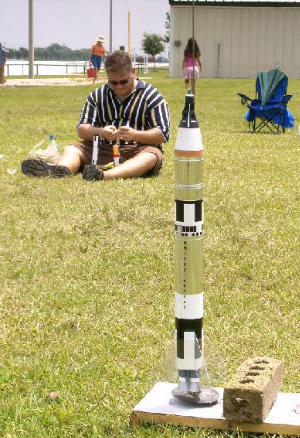
After I completed the finish of my model, I then went about installing the two real 1/8" launch lugs with standoff, using a sharp knife to scrape the appropriate areas for attaching the lug/standoff with CA. When it had dried, I used more CA to fillet/strengthen the joints and allowed everything to fully dry. Afterwards, I used a black paint pen to paint both launch lugs/standoffs black so they can "blend" with the black roll pattern/vent.
For my rating in this category, I'm giving a 4 1/2 even with the issues I had with the decals. Personally, I suspect the decals I got from the kit may have been defective, so I'm not going to blame PDRocketry for this. That's why it pays to get an extra set of decals from Tango Papa just in case. I'm sure PDRocketry would have made good on this issue had I sent an email, but since I was on a self-imposed launch "countdown" timetable, I wouldn't have had the time to wait for new decals to arrive. That's what prompted me to go ahead and hand paint the roll pattern for the Titan's first stage, which came out very good I have to say.
Construction Rating: 4 out of 5
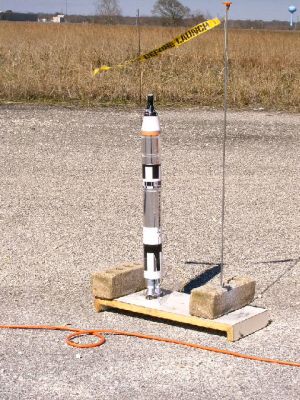
Flight:
Recommended motors for this model are 2 x A8-3, 2 x B6-4, and 2 x C6-5. For my model's first flight attempt, I
decided to use a pair of B6-4s. With all the "extras" included (parachute, wadding and clear plastic fins) my
model weight came to exactly 6.25oz, more than enough for the power of two B6-4s to lift.
Since I've only got one flight in (more added since), I'll give the results here: Not very good. Place: Johnson Space Center. Event: The STARS (NAR Section #672) Texas Winter Regionals. Date: February 18, 2007.
As the pictures show, the model looks really cool on the pad. Prep was the usual stuff: I used about eight squares of the Estes wadding before packing the 24" mylar parachute and elastic shock cord, which was lengthened so the shock cord is 2 1/2 times the length of the model to prevent snapbacks and dinged nose cone.
We had mostly clear, blue skies with temperature around 60 degrees F. and winds holding around 5mph. I used the last two QuickBurst Hot Shot igniters I had in my inventory to be the B6-4s igniters. However, only one igniter lit and the lone B6-4 due to the slight canting of the twin engines went ballistic fairly quickly. The B6s ejection charge went off with the GT-3 about 20-25 feet off the ground with the 24" chute deploying quickly to bring the descent under control. With the very little time between full deployment and the ground, the four clear plastic fins took most of the shock on landing the hard pavement we launch from at JSC and pretty much spared the GT-3 from any serious damage. I have since repaired the clear plastic fin can with the Ambroid Pro-Weld and everything is pretty much ready for another flight in the near future.
Recovery:
Since this first flight was a near failure and not the fault of the model and/or manufacturer (PDRocketry), I will
abstain from rating the Flight/Recovery category.
August 2007 Update: As the latest addition to the Flight Log shows, I flew this model on August 4th and this time the flight was very, very successful. Added the following Rating to my product review:
Flight Rating: 5 out of 5
Summary:
I am extremely pleased with PDRocketry's Gemini Titan 3 kit. It gave me the kind of challenge I seek in a model
rocket kit that really makes me "work" for it. I highly recommend it for those who enjoy having a tough build
in his/her hands. Despite the several frustrations I encountered, in the end I was very satisfied. It definitely felt
like my money spent was well worth it.
Overall Rating: 5 out of 5
Sponsored Ads
 |
 |











